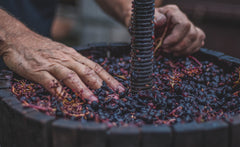Fermented Food History: Vinegar
While interest is growing for fermented foods with their range of health and flavor benefits, the way they're made today can be very different from how they were traditionally produced.
In the first post in this series about the history of some common fermented foods, we review a ubiquitous kitchen staple: vinegar.
What is Vinegar?
A sour-tasting liquid made from fruits or grains, vinegar was originally used as a means to preserve food, add flavor or for its health-giving properties.
Evidence of its production dates back thousands of years and is tied to the stories of some famous historical figures including: Cleopatra, Hippocrates and Hannibal.

Today there are at least six distinct types of vinegar: white, wine, cider, rice, malt and flavored. The product also accounts for a billion-dollar industry in the United States alone.
Vinegar Acidity
An acidic liquid used for pickling, dressings and beyond, vinegar is produced when ethanol (alcohol) is allowed to ferment and turn sour through the action of acetic acid bacteria. In fact the origins of the English word stem from the French term "vin aigre," or "sour wine".
While vinegar can be made from a long list of different ingredients, the resulting liquid should contain at least 4% acetic acid according to the FDA, with a total range up to 20%.
Vinegar Fermentation
Vinegar fermentation can either be spontaneous or managed through the introduction of a "mother" or specific strains of bacteria to a liquid base made from pressed fruit, grains and cereals.

Since ethanol is organically produced by the conversion of carbohydrates (sugars) by yeasts, wine and malted vinegar can also be considered an example of a double-fermented product.
Allowing alcohol to "sit" for several days encourages naturally-occurring acetobacter to colonize the liquid and kick-start the process of converting it to vinegar.
As these bacteria consume the sugars in the ethanol, alcohol is broken down, which is why vinegar isn't typically considered an alcoholic product.
At an industrial scale, the same acetobacter are responsible for converting large vats of alcohol into vinegar, though the aging process (which leads to flavor development) can be severely curtailed versus traditional production methods.
Traditional Vinegar Production Methods
France
While methods of production vary across the world, vinegar production in France has a long history. Many of the world's most popular red and white wine vinegars owe their origins to French wine and culinary traditions.
Here it was traditionally made by either reserving fresh or saving old wine. One of the most famous methods of production, still employed today by a small number of vinegar artisans globally, is the "Orleans" method.
Wine, mixed with a mother, is allowed to mature at room temperature in aerated barrels for several months while bacteria refine the liquid.
Orléans, a town situated along a busy wine route, is thought to have been home to several enterprising local vinegar makers who rescued discarded wine from along the route to turn it into vinegar. Their business became so important that they became an official group in the 14th century, recognized by the king of France in the 17th century.
This vinegar tradition carried over into the domestic arena. Wine was stored in special containers such as ceramic pots or small barrels before being transferred into larger wood barrels (by producers) to age and impart different flavors similar to wine.
Unfortunately the industrialization of food in the 20th century made the economics of this kind of vinegar production much harder to sustain due to the length of time it takes to produce mature vinegars. However some homes today still own the pots, handed down through generations, to make vinegar.
Italy Famous for a rich, complex kind of vinegar known as balsamic vinegar, Italy is actually home to a broad range of styles and kinds of vinegar.
Famous for a rich, complex kind of vinegar known as balsamic vinegar, Italy is actually home to a broad range of styles and kinds of vinegar.
Balsamic however is by far the most famous of these styles, which are categorized into three official categories:
- Aceto Balsamico Tradizionale di Modena DOP;
- Aceto Balsamico Tradizionale di Reggio Emilia DOP;
- Aceto Balsamico di Modena IGP.
Balsamic is traditionally made using grape must, made from either Trebbiano or Lambrusco wine grapes. The must is then aged in wooden barrels for at least 12 years in the Emilia region of Italy, by which time the vinegar has acquired extra flavors from the wood casks.
While traditionally fermented balsamic can be very expensive, mass production of vinegar has led to similar styles of vinegar without the extensive aging process or ingredients. However only traditionally-produced balsamic can carry a recognized seal.
United Kingdom and Beyond
Malt vinegar, traditionally made from germinated fermented barley grain related to beer production, has enjoyed an enduring popularity in the United Kingdom.
 Known for its highly-acidic quality, malt vinegar is typically used to contrast with salty and starchy foods (such as the classic "fish and chips") or to pickle strong flavored vegetables like onions.
Known for its highly-acidic quality, malt vinegar is typically used to contrast with salty and starchy foods (such as the classic "fish and chips") or to pickle strong flavored vegetables like onions.
Having enjoyed a similar level of royal recognition as Orleans style vinegars in France, some British brands of malt vinegar still bear the Royal Warrant on their packaging today.
In a country that still loves its condiments, it isn't unusual to see tables still boasting vinegar pots should eaters require a dash with their meals.
Malt vinegar is technically a kind of spirit vinegar, which refers to the class of vinegars ranging from 5-20% acidity produced through double or secondary fermentation.
Double fermentation is where alcohol is produced through an initial fermentation from grains or fruits, then converted to vinegar through the action of acetic acid producing bacteria.

This is the same process used to produce a range of vinegars from other regions, including sherry vinegar from Spain, apple cider vinegar from the United States or many different grain-based varieties from Asia such as rice wine vinegar.
Each of these vinegars have strong flavors, more or less refined based on their aging method. Apple cider vinegar in particular has enjoyed a strong resurgence in interest among consumers in the past 20 years, touted for its health-giving qualities.
While the complex history, production and many types of vinegar warrant a far longer post, we hope this overview provides a helpful taster of one of the world's most enduring fermented food products!
---
Sample a new secondary fermented food product: New York's own Cultured Coffee!



Leave a comment
Please note, comments must be approved before they are published